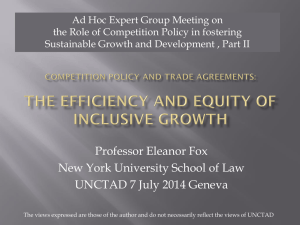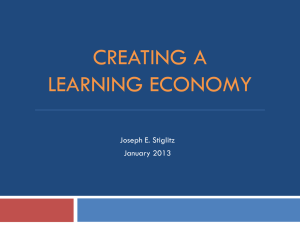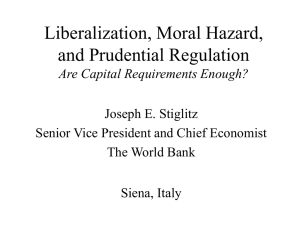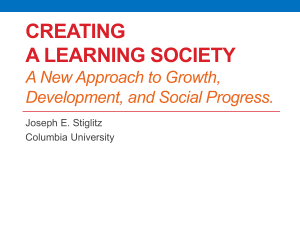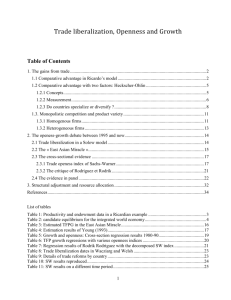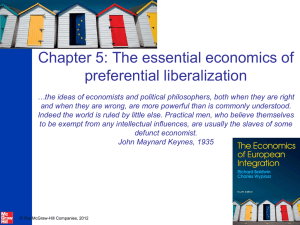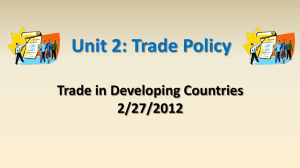Gender and Trade Liberalization in Africa.. Towards a Level Playing
advertisement
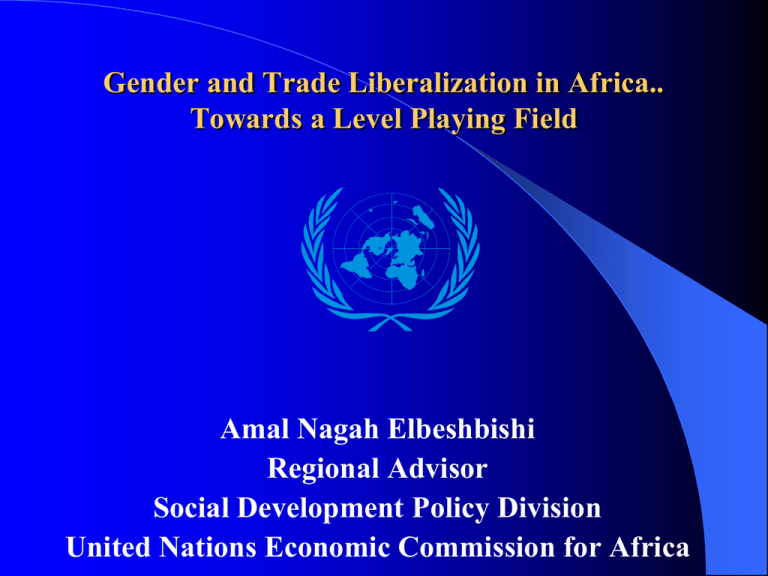
Gender and Trade Liberalization in Africa.. Towards a Level Playing Field Amal Nagah Elbeshbishi Regional Advisor Social Development Policy Division United Nations Economic Commission for Africa Outline I. Introduction II. Trade Liberalization and Gender Gap III. Trade Liberalization and Women’s Employment IV. Trade Liberalization and Women Farmers V. Policy Recommendations “If the playing field is level and all the rules are clearly defined, we will all excel” Reverend Jessie Jackson I. Introduction • The institutional framework of the Multilateral Trading System (MTS) is based on the assumption that trade policies and agreements are gender neutral. • This underlying assumption has led to the neglect of gender as a variable in trade policy making. • Trade has very different impacts on men and women due to gender roles and relationships of unequal power. • Although we know that women in Africa are the majority of the poor and low- skilled workers, there is very little known on the impact of trade liberalization on them, partly because of lack of gender-disaggregated data in trade statistics, and partly because of lack of gender awareness in economic analysis. II. Trade Liberalization and Gender Gap • Women continue to exist in roles and relationships that make them subordinate to men in many African countries, . These inequalities severely limit their capacity to engage in and benefit from trade. As underlying gender systems in most of these countries are grounded in biases and discrimination against women shifts in trade policy in accordance with global trade rules will inevitably impact on the underlying system of gender relations. II. Trade Liberalization and Gender Gap (Continued) • Barriers to women entrepreneurs’ participation in international trade range from lack of business skills, to lack of knowledge of the rules governing international trade transactions and of technical regulations and standards to be respected in order to gain access to specific export markets II. Trade Liberalization and Gender Gap (Continued) • No country undertaking trade liberalization does so from a starting point of equality between men and women. If women are disproportionately excluded from the benefits of trade liberalization, or bear a heavier burden of the costs of adjustment, the result will be an increase in gender inequality. This is not only costly for women, but it further complicates the challenge of poverty reduction. Gender inequality itself limits growth, which may be a further constraint in achieving pro- poor impacts from trade liberalization. II. Trade Liberalization and Gender Gap (Continued) • Where trade liberalization results in falling incomes, and greater pressures on women to increase income- earning activities, the result can be even greater pressures on women’s time and health and, thus, an intensification of other forms of deprivation. Other coping mechanisms could include the withdrawal of girls from school to assist with household work, with a different set of long- term costs. II. Trade Liberalization and Gender Gap (Continued) Young women usually respond more to the demands of family and are particularly likely to leave school for the immediate rewards of any export job. Thus export jobs, for example, are not a ladder up but it’s a poverty trap for women. Why poverty trap? Because short-term income rises, but long-term poverty persists due to education gap, since it reduce school attendance. Young female workers trapped in dead-end export jobs. III. Trade Liberalization and Women’s Employment • Trade liberalization typically results in an increase in labor- intensive exports from African countries. Production of many of these exports requires manual dexterity and stamina but not great physical strength. The growth of exports such as garments, shoes, jewelry, and electronics has almost always been accompanied by a significant increase in female employment in the formal sector. III. Trade Liberalization and Women’s Employment (Continued) • A large influx of unskilled women workers into the labor force, caused by the expansion of export industries, may exert downward pressure on their wages. Because of their weaker bargaining power, women are often the victims of international cost competition. III. Trade Liberalization and Women’s Employment (Continued) • Although women are the heartbeat of trading in Africabut they are over represented in low- paid exportoriented sectors such as horticultural, floricultural sectors and in fisheries. In the manufacturing sector, they are the majority of assembly workers (textiles and clothing). Women were also found to be in the minority at supervisory and managerial levels, locking them into jobs whose pay levels were reported as insufficient in meeting their basic family needs. III. Trade Liberalization and Women’s Employment (Continued) • Export expansion may provide more paid work to women while trade liberalization will likely have indirect effects on women’s unpaid work via its effects on public finance. Tax revenue from trade taxes has fallen in many African countries. This has led to reductions in public expenditure (measured as a share of GDP) on infrastructure, education and health. In turn, this is likely to increase women’s unpaid work burden, as they will try to produce substitutes for public services. III. Trade Liberalization and Women’s Employment (Continued) • Women’s heavy burden of household responsibilities, as well as their weaker property rights to land and other resources, are likely to have contribute to the weak supply response of African agriculture to export opportunities in countries such as Burkina Faso, Tanzania, Togo and Zambia. IV. Trade Liberalization and Women Farmers • The logic of competition and ‘free trade’ enshrined in the WTO’s Agreement on Agriculture (AoA) has been applied to an uneven- playing field that pits smallholder agriculture, many of which are women against transnational agro- business. • Many women farmers in African countries are increasingly losing domestic markets to cheap food imports from developed countries. This puts a downward pressure on farm gate prices and along with the removal of subsidies (for fertilizers and assistance with irrigation) creates extreme hardship for women farmers as well as for women in their roles as providers of family well being. IV. Trade Liberalization and Women Farmers (Continued) Although women, in their role as consumers, may benefit from lower prices of imported goods, women who are small- scale producers may be negatively affected by these policies. For example, in Senegal, women had switched to growing tomatoes and they had taken out micro- credit loans to start producing tomato paste. However, when the government lowered tariffs on food imports due to trade liberalization, cheap foreign tomatoes flooded the market, so women could not pay back the loans, thus they ended up in worse economic shape than when they had started out. IV. Trade Liberalization and Women Farmers (Continued) Trade liberalization in Ghana was found to benefit medium and large-scale farmers in the cocoa sector where few women are employed IV. Trade Liberalization and Women Farmers (Continued) In many African countries although women constitute the backbone of agricultural production and their work is critical for food security, they are usually small farmers or engage predominantly in the production of food crops. Trade liberalization tends to advantage large and medium producers, and disadvantage smaller ones, partly through intensified import competition. When opportunities emerge with new markets, women are slow to take advantage of them, as they lack access to credit, new technologies, and knowledge of marketing. IV. Trade Liberalization and Women Farmers (Continued) Although demand for labor in high- value agricultural export production has created new economic opportunities for women, their working conditions are characterized by insecurity, long working hours, environmental health hazards, low wages, and limited opportunities for training and skill development. The competition among agribusiness firms, particularly horticultural export firms, pressures them to reduce costs by hiring unskilled women as informal workers (i.e. temporary, seasonal, and casual) at low wages and without social benefits. Little or no advance notice is given when workers are laid off. V. Policy Recommendations • Mitigating potentially- negative effects on specific sectors and on women that would exacerbate existing gender inequality, through attention to the timing and phasing- in of liberalization measures to allow for necessary adjustments and policy measures to support that adjustment process. V. Policy Recommendations (Continued) • Trade ministries, trade negotiators and delegates should recognize the gender differentiated impacts of trade liberalization, and the central role of gender equality in ensuring the integration of systematic gender analysis in trade policy making and negotiations, support the creation of women’s cooperatives and enterprises in order to facilitate their access to information, communication technologies and trading networks, and ensure the alignment of trade policy with gender equality and poverty reduction objectives. V. Policy Recommendations (Continued) • Gender analysis and perspectives should be systematically integrated into trade- related capacity building programmes of international finance institutions, donors and intergovernmental organizations. Gender should be recognized as a cross- cutting issue. All regional and international trade agreements should incorporate a gender analysis in all policies. V. Policy Recommendations (Continued) • Regional Economic Communities (RECs), should review and update existing gender policy frameworks to cover issues and commitments regarding gender and trade, establish a continuing dialogue on gender issues with trade policy makers and negotiators in the national and international arenas, and organize expert group meetings, ad- hoc working groups in specific areas, and broad- based consultations with civil society groups, trade justice activists, parliamentarians and women’s organizations on gender and trade. V. Policy Recommendations (Continued) • United Nations organizations such as ECA should continue to provide cutting- edge research and analysis on gender and trade issues; assist in the development of tools for the formulation and implementation of gender aware trade policies; provide support for the promotion of regional/ sub- regional networks of women entrepreneurs and exporters, with special attention to SMEs and the informal sector; train government and NGOs’ representatives to monitor gender- differentiated impacts of trade policy in the context of development plans; and provide support in identifying markets and products of interest to women traders. Thank You
